Fire Pump Design and Installation Service
We are trusted by countless clients for delivering efficient fire pump designs.
We comply with local and national codes for superior safety and protection.
Our fire pumps supply water to your sprinklers and mist systems when they need it most.
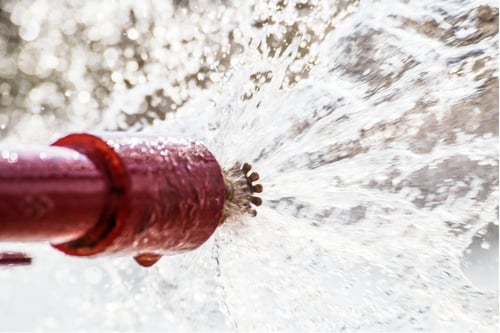
Fire is the biggest enemy of any property and life. Whether commercial, industrial or residential, fires can cause massive damage to buildings and also result in loss of lives. The threat of fire is considerably higher in the cities where buildings are crowded together which also encourages the spread of fires.
According to the United States Fire Administration, there were 1,319,500 fires alone in 2017. The fires caused the death of 3,400 civilians and injured 14,670 others. In total, the fires resulted in a loss of $23 billion in 2017.
It's imperative and mandatory for buildings and properties across the USA to have adequate fire fighting systems. An integral part of fire fighting systems is sprinklers and mist systems which can potentially put out a fire before it turns dangerous. And to make the sprinkler systems work you need water, which is mostly supplied by fire pumps.
A fire pump is the heart of any fire protection and fire fighting system. You cannot expect your sprinklers or mist systems to work unless you have adequate fire pumps in your property. New York Engineers designs state-of-the-art fire pumps that integrate with your fire fighting devices to ensure a steady supply of water.
Our engineers have worked on countless fire pump projects and know how to design resilient and effective fire pumps for any type of building or property. We also undertake inspection, testing and maintenance of fire pumps and offer expert installation services following all regulations and codes.
If you are planning a new construction, be sure to approach us in time so that we can create and integrate your fire pumps in the plan with the least resources and cost. We also design and install fire pumps for existing properties to enhance your current fire protection systems. Our team can design entire fire pump infrastructure complete with standpipes, piping, sprinkler systems and fire detection systems.
We help you protect your property and occupants in the most effective ways.
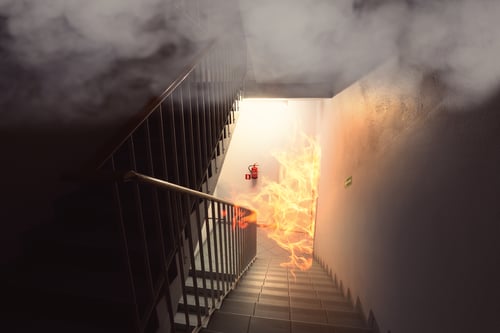
Buildings across the USA are mandated to have adequate fire fighting systems installed on the property. Devices like sprinklers and mist systems can be linked with fire detection devices to sense a fire and automatically turn on water supply in case a fire breaks out. Now, you will need to supply water to the sprinklers at a set pressure so that they can effectively put out fires.
In many areas, the municipal water system is unable to deliver the required water pressure to meet the hydraulic demands of fire fighting systems like sprinklers. It is mostly true for multi-storied buildings which have water tanks located at the ground level. The sprinklers may also experience a drop of water pressure when all of the water outlets are opened or there is a leak in the system.
In the above cases, you need something to bring the water pressure back so that your sprinklers can function. A fire pump serves the need for maintaining water pressure and supplies water to the fire fighting systems when the pressure drops below a threshold. Fire pumps may also be necessary for the normal functioning of sprinklers in buildings higher than five or six stories.
Fire pumps are generally connected to sources of water like storage tanks or wells. The pumps draw the water from the source and deliver it to the fire fighting systems. You will need a fire pump as a part of effective fire protection systems to save lives and reduce damages to your property.
New York Engineers can help you out if you are looking to install or upgrade your fire pumps. We deliver the highest standards in designing and installation to create resilient fire protection systems that never let you down!
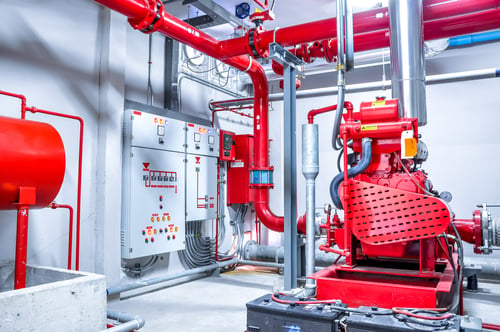
All fire pumps perform the basic function of delivering adequate pressure to your fire fighting systems to ensure a steady supply of water. You will find different types of fire pumps in the market like horizontal split case, vertical split case, vertical in-line and vertical turbine. Let's check out what each type entails-
Horizontal Split Case
Horizontal split case pumps are the most common fire pumps found in buildings and high rises. You will need a separate water source for the pumps that deliver a positive suction pressure. Horizontal split case pumps are popular because they are easy to work with and you can have quick access to all working parts.
The pumps can efficiently move huge amounts of water and provide long-term dependability. You can also find various sizes of horizontal split case pumps to suit firefighting equipment of all sizes.
Vertical Split Case
Vertical split case pumps work on a similar principle like horizontal split case pumps. The only difference is that the pump and motor have a vertical orientation. The built of the pump offers advantages for applications with space restrictions. The pumps take up less floor space and are suitable for buildings or businesses who don't have ample room to spare.
The vertical orientation of the pump also protects the motor from flooding, making it a preferred choice in flood-prone areas. You will need a separate water source for vertical split case pumps that provides positive suction pressure.
Vertical In-Line
Vertical in-line pumps also come with a vertical motor orientation like vertical split case pumps. Vertical in-line pumps are compact and generally smaller than split case pumps. You can ideally use them for pump rooms with limited space as they require less floor space.
Another advantage of this type of pump is that you don't need special foundations or pads as it comes with in-line mounting. Like the above pumps, you will need a positive suction pressure for the pumps to work.
One drawback of vertical in-line pumps is that you have to remove the entire driver unit to carry out repairs or maintenance.
Vertical Turbine
Vertical turbine pumps differ from the other types as they don't require a water source for providing positive suction pressure. The pumps can use the water from nearby water tanks or wells in case a fire breaks out. Most commonly we design vertical turbine pumps to draw water from underground wells or tanks. During operation, the pumps deliver the water up the column pipe to the pump discharge.
Vertical turbine pumps can operate without priming.
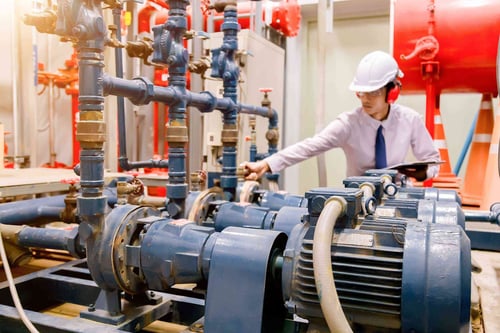
You can also classify fire pumps into three categories based on their power source:
Diesel Powered Pumps
Diesel-powered fire pumps use diesel for their power source. They don't need any electricity and can work as long as there is fuel in the storage tank. The NFPA 20 lays down guidelines for the design and installation of diesel fire pumps.
Electric Fire Pumps
Electric fire pumps are widely used for their compact size and environmental friendliness. The pumps use electric motors and need a steady supply of electricity to function. Electric fire pumps also need fewer accouterments but rely completely on infrastructure.
Steam Turbine Fire Pumps
Steam turbine fire pumps are also accepted under the codes but they are rarely used. The pumps are powered by steam turbines and don't need any fuel or electricity. The pumps can help you save initial costs and utility bills along with lowering your repair costs.
We help you choose the right type of fire pumps for your project so that you have the maximum ability to mitigate fires. The type of fire pump you need will be decided by your objectives, nature of fire fighting systems, availability of water and more. You can rely on us completely to select the right fire pump to meet your unique needs.
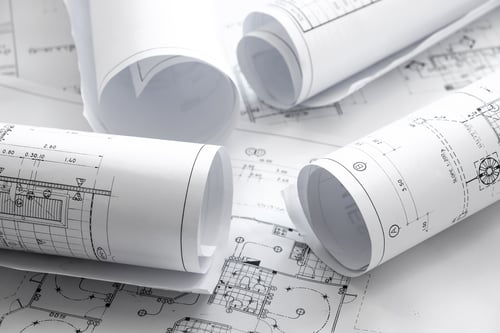
Our team has a proven process in place to design the most effective fire pump systems. Let's take a brief look at our fire pump design process:
The first step is to determine the source of water supply for your fire pump. You can draw water from the main supply, water tanks or wells in your property. We will work out your water source and create your fire pump design based on it.
If you don't have the necessary water source, we can also design required storage tanks for the purpose.
We will need to determine the sizing of the fire pump suitable for your project. Our team can measure the required water pressure to determine the size fit for you. We use various approaches to find out the required water pressure such as the standpipe method or the sprinkler area method.
You don't need to fret about the calculations, as our engineers will take care of the numbers and mathematics to determine the required gpm and psi of your pump!
Next, we put our heads together to determine the best type of fire pump for your property. We will choose from the types we discussed above- horizontal split case, vertical split case, vertical turbine and so on. Our team will also work out which type of power supply will be most beneficial for you. Based on our analysis, we can go for either a diesel, electric or steam pump that meets your pressure requirements.
We have to follow several implications while choosing the location of the pump room (if you don't already have one). This is true for new constructions and we may need to review your plans for performing this step. We also comply with all NFPA and IBC standards that deal with the location of fire pumps.
The last step is to install the fire pumps on your property at the chosen location. Our expert team ensures a quality installation leaving no room for mistakes. We connect the fire pumps to your fire fighting systems and water source with all required fittings and piping so that they are fully functional. Our installation process also complies with all applicable codes and local fire regulations.
New York Engineers is a trusted leader in fire protection system design and installation. Our team is experienced and nuanced to carry out fire pump designs for buildings of all sizes and types. We design fire pumps for homeowners, businesses and industries, helping them to create effective fire fighting systems to tackle mishaps with minimum damages. Our fire pumps offer reliable performance arming your fire protection devices with a ready supply of water.
Get in touch with us to discuss your fire pump project at the earliest.